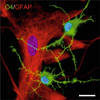Investigation of astrocyte - oligodendrocyte interactions in human cultures
- PMID: 22144322
- PMCID: PMC3299010
- DOI: 10.1007/978-1-61779-452-0_27
Investigation of astrocyte - oligodendrocyte interactions in human cultures
Abstract
Multiple sclerosis (MS) is characterized by CNS demyelination and oligodendrocyte depletion, axonal loss, and reactive astrogliosis. Myelin loss causes conduction block, while remyelination is associated with recovery of conduction and return of function. Reactive astrocytes are a prominent feature of MS plaques, and have been implicated as producing factors regulating oligodendrocyte progenitor differentiation and myelin formation. Understanding their impact on these events may lead to new approaches for oligodendrocyte protection and/or remyelination in MS. Here, we outline protocols for the establishment and analysis of primary monocultures and cocultures of human astrocytes and oligodendrocytes. These approaches are designed to facilitate analysis of mechanisms underlying astrocytic regulation of progenitor survival and myelin repair.
Figures

Similar articles
-
The role of oligodendrocytes and oligodendrocyte progenitors in CNS remyelination.Adv Exp Med Biol. 1999;468:183-97. doi: 10.1007/978-1-4615-4685-6_15. Adv Exp Med Biol. 1999. PMID: 10635029 Review.
-
White matter astrocytes in health and disease.Neuroscience. 2014 Sep 12;276:161-73. doi: 10.1016/j.neuroscience.2013.10.050. Epub 2013 Nov 11. Neuroscience. 2014. PMID: 24231735 Free PMC article. Review.
-
Axon-oligodendrocyte interactions during developmental myelination, demyelination and repair.J Neurochem. 2010 Sep 1;114(5):1243-60. doi: 10.1111/j.1471-4159.2010.06831.x. Epub 2010 May 26. J Neurochem. 2010. PMID: 20524961 Review.
-
An in vitro assay to examine oligodendrocyte precursor cell migration on astrocytes.Methods Mol Biol. 2012;814:393-9. doi: 10.1007/978-1-61779-452-0_26. Methods Mol Biol. 2012. PMID: 22144321
-
Interleukin-11 potentiates oligodendrocyte survival and maturation, and myelin formation.J Neurosci. 2006 Nov 22;26(47):12174-85. doi: 10.1523/JNEUROSCI.2289-06.2006. J Neurosci. 2006. PMID: 17122042 Free PMC article.
Cited by
-
Robust induction of functional astrocytes using NGN2 expression in human pluripotent stem cells.iScience. 2023 May 30;26(7):106995. doi: 10.1016/j.isci.2023.106995. eCollection 2023 Jul 21. iScience. 2023. PMID: 37534135 Free PMC article.
-
ERK1/2 Signalling Pathway Regulates Tubulin-Binding Cofactor B Expression and Affects Astrocyte Process Formation after Acute Foetal Alcohol Exposure.Brain Sci. 2022 Jun 22;12(7):813. doi: 10.3390/brainsci12070813. Brain Sci. 2022. PMID: 35884621 Free PMC article.
-
Astrocytes in the central nervous system and their functions in health and disease: A review.World J Clin Cases. 2023 May 26;11(15):3385-3394. doi: 10.12998/wjcc.v11.i15.3385. World J Clin Cases. 2023. PMID: 37383914 Free PMC article. Review.
-
The significance of matrix metalloproteinases in the immunopathogenesis and treatment of multiple sclerosis.Sultan Qaboos Univ Med J. 2014 Feb;14(1):e13-25. doi: 10.12816/0003332. Epub 2014 Jan 27. Sultan Qaboos Univ Med J. 2014. PMID: 24516744 Free PMC article. Review.
-
Human iPSC Glial Mouse Chimeras Reveal Glial Contributions to Schizophrenia.Cell Stem Cell. 2017 Aug 3;21(2):195-208.e6. doi: 10.1016/j.stem.2017.06.012. Epub 2017 Jul 20. Cell Stem Cell. 2017. PMID: 28736215 Free PMC article.
References
-
- Raine CS, McFarland HF, Tourtellotte WW. Multiple sclerosis : clinical and pathogenic basis. 1st ed. London; New York: Chapman & Hall Medical; 1997.
-
- Smith KJ, Blakemore WF, McDonald WI. The restoration of conduction by central remyelination. Brain. 1981;104:383–404. - PubMed
-
- Bush TG, Puvanachandra N, Horner CH, Polito A, Ostenfeld T, Svendsen CN, Mucke L, Johnson MH, Sofroniew MV. Leukocyte infiltration, neuronal degeneration, and neurite outgrowth after ablation of scar-forming, reactive astrocytes in adult transgenic mice. Neuron. 1999;23:297–308. - PubMed
-
- John GR, Shankar SL, Shafit-Zagardo B, Massimi A, Lee SC, Raine CS, Brosnan CF. Multiple sclerosis: re-expression of a developmental pathway that restricts oligodendrocyte maturation. Nat Med. 2002;8:1115–1121. - PubMed
Publication types
MeSH terms
Grants and funding
LinkOut - more resources
Full Text Sources
Other Literature Sources
Medical

